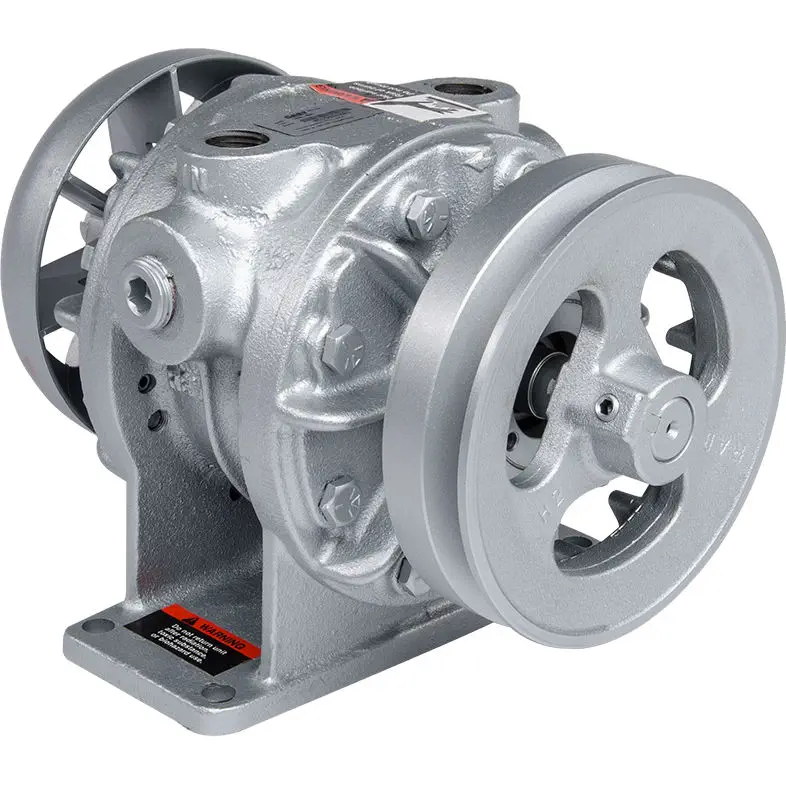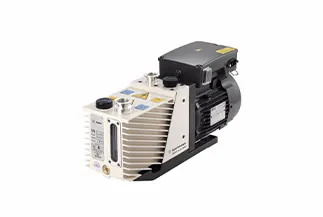Product Description
Product Parameters
| Model | 2xz-0.5 | 2xz-1 | 2xz-2 | 2xz-4 | |
| Pumping Speed L/S(m³/h) | 0.5(1.8) | 1(3.6) | 2(7.2) | 4(14.4) | |
| Extreme Pressure(Pa) | Partial Pressure | ≤6×10-2 | ≤6×10-2 | ≤6×10-2 | ≤6×10-2 |
| Full Pressure | ≤1.33 | ≤1.33 | ≤1.33 | ≤1.33 | |
| Rotating Speed r/min(50/60Hz) | 1400/1700 | 1400/1700 | 1400/1700 | 1400 | |
| Voltage(v) | 220 | 220/380 | 220/380 | 220/380 | |
| Motor Power(kw) | 0.18 | 0.25 | 0.37 | 0.55 | |
| Inlet Diameter (Outer Diameter)mm | G3/8(∅12) | G3/8(∅12) | G3/4(∅12) | G3/4(∅12) | |
| KF-16 | KF-16 | KF-25 | KF-25 | ||
| Noise(dBA) | 62 | 62 | 63 | 64 | |
| Oil volume (L) | 0.6 | 0.7 | 1 | 1.1 | |
| Size(mm) | 538*215*360 | 538*215*360 | 580*215*367 | 580*215*367 | |
| Gross/Net Weight(kg) | 17/16 | 18/17 | 22/20 | 25/22 | |
| Model | 2xz-2B | 2xz-4B | 2xz-6B | 2xz-8B | 2xz-15B | 2xz-25B | |
| Pumping Speed L/S(m³/h) | 2(7.2) | 4(14.4) | 6(21.6) | 8(28.8) | 15(54) | 25(90) | |
| Extreme Pressure(Pa) | Partial Pressure | ≤4×10-2 | ≤4×10-2 | ≤4×10-2 | ≤4×10-2 | ≤4×10-2 | ≤4×10-2 |
| Full Pressure | ≤1 | ≤1 | ≤1 | ≤1 | ≤1 | ≤1 | |
| Rotating Speed r/min(50/60Hz) | 1400/1700 | 1400/1700 | 1400/1700 | 1400/1700 | 1400/1700 | 1400/1700 | |
| Voltage(v) | 220/380 | 220/380 | 220/380 | 380 | 380 | 380 | |
| Motor Power(kw) | 0.37 | 0.55 | 0.75 | 1.5 | 1.5 | 2.2 | |
| Inlet Diameter (Outer Diameter)mm | G3/4 | G3/4 | ∅30 | ∅40 | ∅40 | ∅50 | |
| KF-25 | KF-25 | KF-25 | KF-40 | KF-40 | KF-50 | ||
| Noise(dBA) | 65 | 66 | 68 | 70 | 72 | 74 | |
| Oil volume (L) | 0.8 | 0.95 | 1-1.2 | 2.3-2.5 | 2.8-3.3 | 5.5-6.5 | |
| Size(mm) | 580*215*367 | 580*215*367 | 670*240*320 | 720*270*390 | 770*270*390 | 900*320*550 | |
| Gross/Net Weight(kg) | 22/20 | 25/22 | 46/40 | 68/52 | 75/62 | 90/70 | |
Product Description
Rotary Vane Vacuum Pump is the basic equipment used to remove gas from sealed containers. It can be used alone, also can be used for booster pump, diffusion pump, molecular pump before the pump, maintenance pump, titanium pump pre-pumping pump, It can be used for vacuum drying, CHINAMFG drying, vacuum degassing, vacuum packaging, vacuum adsorption, vacuum forming, coating, food packaging, printing, sputtering, vacuum casting, instruments, instruments, refrigerators, air conditioning lines and laboratories and other vacuum operations and supporting use.
· Due to the thorough low noise design and precision machining, so as to achieve low noise
· Specially designed gas valve is prepared to prevent the pump oil from mixing with water and prolong the service time of the pump oil
· Adopt similar product design, small size, light weight, low noise, easy to start
· Equipped with vacuum drying oven, freeze-drying machine, printing machinery
· It can be equipped with small-caliber adapter, KF interface and flange interface
Application
· Rotary Vane Vacuum Pump corollary use with freezer dryer to reach vacuum state, it’s an essential corollary equipment in medicine CHINAMFG drying, biology, food industry and agricultural products deep processing
· Rotary Vane Vacuum Pump corollary use with vacuum drying oven for maintaining vacuum state inside the oven, they mainly applies in powder drying and baking in vacuum condition
Company Profile
Packaging & Shipping
FAQ
Q1. What is your products range?
• Industry water chiller, recirculating cooling chiller, rotary evaporator, alcohol recovery equipment, short path distillation kit, glass molecular distillation equipment, falling film evaporator, jacketed glass reactor and other lab equipment.
Q2. Are you trading company or manufacturer?
• We are professional manufacture of lab equipment and we have our own factory.
Q3. Do you provide samples? Is it free?
• Yes, we could offer the sample. Considering the high value of our products, the sample is not free, but we will give you our best price including shipping cost.
Q4. Do you have warranty?
• Yes, we offer 1 year warranty for the spare part.
Q5. How long is your delivery time?
• Generally it is within 7 working days after receiving the payment if the goods are in stock. Or it is 15 working days if thegoods are not in stock, depending on order quantity.
Q6. What is your terms of payment?
• Payment≤15,000USD, 100% in advance. Payment≥15,000USD, 70% T/T in advance, balance before shipment.
(If you are concerned about payment security for the first order, we advise you can place Trade Assurance Order via Alibaba. you will get 100% payment refund if we can’t meet agreed delivery time.)
/* January 22, 2571 19:08:37 */!function(){function s(e,r){var a,o={};try{e&&e.split(“,”).forEach(function(e,t){e&&(a=e.match(/(.*?):(.*)$/))&&1
| After-sales Service: | Online Service Support |
|---|---|
| Warranty: | 1 Year |
| Oil or Not: | Oil |
| Customization: |
Available
|
|
|---|
.shipping-cost-tm .tm-status-off{background: none;padding:0;color: #1470cc}
| Shipping Cost:
Estimated freight per unit. |
about shipping cost and estimated delivery time. |
|---|
| Payment Method: |
|
|---|---|
|
Initial Payment Full Payment |
| Currency: | US$ |
|---|
| Return&refunds: | You can apply for a refund up to 30 days after receipt of the products. |
|---|

Can rotary vane pumps be used in medical or laboratory applications?
Yes, rotary vane pumps can be used in medical or laboratory applications. Rotary vane pumps are a type of positive displacement pump that use vanes mounted on a rotor to create suction and move fluids. They are commonly used in a variety of industries, including medical and laboratory settings, due to their reliable performance and ability to handle a wide range of fluids.
In medical applications, rotary vane pumps can be used for tasks such as vacuum aspiration, vacuum filtration, and vacuum drying. They are often employed in medical laboratories for sample preparation, where they help create vacuum conditions necessary for various processes, such as evaporation, distillation, and filtration. Rotary vane pumps can also be used in medical devices such as vacuum ovens, freeze dryers, and vacuum concentrators.
In laboratory settings, rotary vane pumps are utilized for numerous applications. They are commonly used in vacuum systems to create and maintain the necessary vacuum levels for experiments, particularly when working with sensitive samples or volatile substances. Rotary vane pumps can generate a high vacuum level and provide a stable vacuum source, making them suitable for tasks such as rotary evaporation, degassing, and gas analysis.
It’s worth noting that when rotary vane pumps are used in medical or laboratory applications, they need to meet certain requirements and standards to ensure safety and reliability. For example, pumps used in medical settings may need to comply with medical device regulations and standards, while pumps used in laboratories may need to meet specific requirements for chemical compatibility, noise levels, and performance specifications.
In summary, rotary vane pumps are well-suited for medical and laboratory applications due to their ability to create and maintain vacuum conditions. They offer reliable performance and versatility, making them a popular choice in various scientific and healthcare settings.

What Are the Main Components of a Rotary Vane Pump?
A rotary vane pump consists of several key components that work together to create a pumping action. Here’s a detailed explanation of the main components:
– Rotor: The rotor is the central rotating element of the rotary vane pump. It is typically made of a durable material such as stainless steel or cast iron. The rotor is connected to a drive mechanism, such as an electric motor, which provides the rotational power.
– Vanes: The vanes are sliding elements that are inserted into radial slots in the rotor. They can be made of various materials, including carbon, graphite, or synthetic materials. The number of vanes in a rotary vane pump can vary, but typically there are multiple vanes evenly spaced around the rotor. The vanes are crucial for creating a seal against the stator walls and for generating the pumping action.
– Stator: The stator is the stationary part of the rotary vane pump. It forms the pump chamber and provides the housing for the rotor and vanes. The stator is typically cylindrical in shape with an eccentric bore that accommodates the rotor. It is commonly made of materials such as cast iron or stainless steel to ensure durability and resistance to wear.
– Inlet and Outlet Ports: The rotary vane pump has separate inlet and outlet ports. The inlet port allows the entry of gas or fluid into the pump, while the outlet port facilitates the discharge of the pumped medium. These ports are strategically positioned on the pump housing to enable the flow of the medium in and out of the pump.
– Seals: Seals are essential components of a rotary vane pump as they prevent leakage and maintain the integrity of the pumping system. The primary seal is formed between the vanes and the stator walls, ensuring that gas or fluid is contained within the pump chamber during the pumping process. Additional seals may be present at the inlet and outlet ports to prevent any leakage at these points.
– Lubrication System: Rotary vane pumps often require lubrication to minimize friction and wear between the rotating components. Lubrication is typically achieved by introducing a small amount of oil or lubricant into the pump chamber. The lubricant helps reduce friction between the vanes and the stator walls, ensuring smooth operation and extending the lifespan of the pump.
– Exhaust Valve: Some rotary vane pumps feature an exhaust valve, also known as an anti-suckback valve. This valve is located at the outlet port and prevents the reverse flow of gas or fluid back into the pump when it is not in operation. The exhaust valve helps maintain the integrity of the vacuum or pressure created by the pump.
– Drive Mechanism: The drive mechanism provides the rotational power to the rotor, enabling the pumping action. In most cases, an electric motor is used as the drive mechanism, although other power sources such as hydraulic or pneumatic systems can also be employed.
– Base or Mounting Plate: The base or mounting plate provides a stable platform for the rotary vane pump. It is typically made of sturdy materials such as cast iron or steel and is designed to support the weight of the pump and provide a secure attachment point for installation.
– Control and Monitoring Devices (Optional): Depending on the specific application, rotary vane pumps may be equipped with control and monitoring devices. These can include pressure sensors, flow meters, temperature sensors, and control panels that allow for the regulation and monitoring of pump performance.
– Safety Features (Optional): Some rotary vane pumps may include safety features such as overpressure relief valves or automatic shutdown mechanisms to prevent damage to the pump or the system in case of abnormal operating conditions.
In summary, the main components of a rotary vane pump include the rotor, vanes, stator, inlet and outlet ports, seals, lubrication system, exhaust valve, drive mechanism, base or mounting plate, as well as optional control and monitoring devices and safety features. These components work together to create a continuous pumping action and ensure the efficient operation of the rotary vane pump.


editor by Dream 2024-04-30
by
Tags:
Leave a Reply